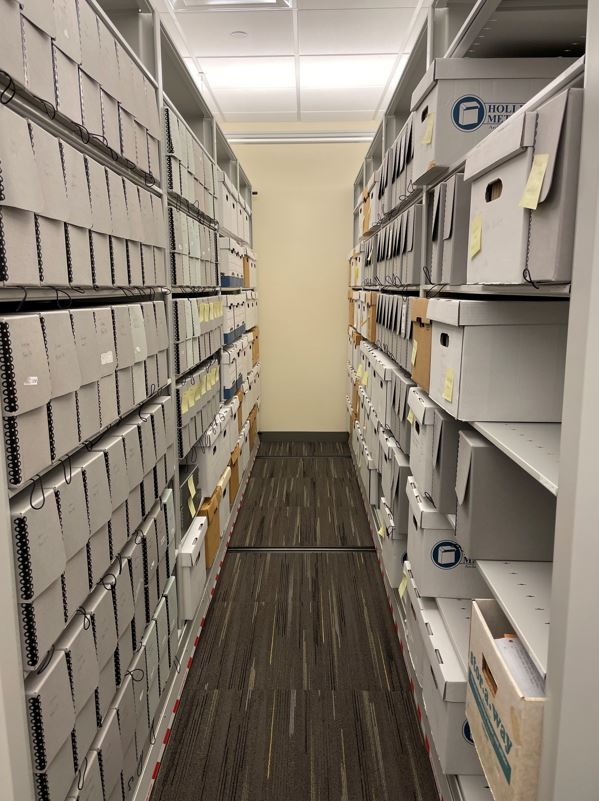This blog post was written by Rachel Barton, GRA for the Buchanan Papers processing project. The project is supervised by Buchanan Papers Project Archivist Rebecca Thayer and is grant funded by the National Endowment for the Humanities.
If you had asked me 10 years ago about whether I thought that I would be working in the Special Collections Research Center of Fenwick Library, I would have said yes, since at the time I was employed by my local public library doing clerical work. It was heavy, complex stuff – stamping books, helping older patrons use the by then decade-old Mac desktop computers, and reorganizing the children’s section after preschool field trips, in addition to a hundred other tasks. While the work that I am currently doing is a far cry from shelving the same 10 volumes of The Sopranos on VHS tape or taping check out slip holders to the inside covers of books, I find myself just as engaged with library and collections culture.
I am now enrolled in George Mason’s graduate history program, a decade later, with that same interest in public history and libraries. At the moment, I am not sure what I want to do as a career specifically, but I do know that I would like it to be in this realm. It was by pure chance that I found the advertisement for the graduate research assistant position on the Buchanan Papers Project, and I was thrilled by it. At the time I had a full time management job in retail – but I wanted to do something else, something more relevant to the path that I have been taking. This was an incredible opportunity for me, a way to get my foot in the proverbial door of a career that I have been interested in since middle school. I can not articulate just how excited I was to be hired and to get my hands in this field for real.
In my time since beginning my research assistant position on the Buchanan Papers Project at Mason’s SCRC, I have had quite a bit of learning to do. At first, the world of archives and special collections seemed large and like a different, yet similar, mirrored world from what I am used to. I am a historian and teacher by training; I have a Master of Arts in teaching and a Bachelor of Arts in history. In these spheres of my identity, I take sources and turn them into something else – something easily communicable to my audience (students, the general public, academics). I analyze the sources, explicating key ideas and themes from it. In this, archival work is not so different. Rather than analyzing, archival work takes sources and categorizes them, preserves them, and arranges them into a format easily communicable to the intended audience (historians, economists, political scientists, scholars of various other fields). The work itself is not transformed; instead, it is organized and preserved.
My learning, and learning curve, has largely been centered around understanding the complexities of and steps within processing, and I have been provided ample resources to study from. My encyclopedia of information / all-knowing search engine / constant companion has been the center’s Processing Manual, lovingly put together by the staff. I am currently on my 10th read through of it, in all its glory. And thanks to Rebecca and the extremely helpful staff of the SCRC, I have had plenty of additional questions answered. From these main sources, I’ve learned the fundamentals of arrangement – what to and not to do.

Buchanan papers records boxes. Photo by Amanda Brent.
The practical experience that I have with this project has been largely foldering, sorting, and alphabetizing/chronologizing the existing categories. My first few months on the project were centered on alphabetizing Buchanan’s correspondence. The category was essentially split into two sections, and I spent the majority of my time merging the two. It was a long process – I titled unlabeled folders, hauled boxes from one end of the stacks to the other, and did the obvious alphabetization of over several hundred different items in 50+ original boxes. This experience was an excellent introduction to the world of archival work, as it encompasses several large parts of processing.
The operation of melding the disjunct parts of the correspondence category was interesting, and I remained engaged throughout the endeavor. I think my favorite aspect of that particular project was leafing through the interesting letters and getting a little glimpse into Buchanan’s interpersonal connections. I particularly enjoyed letters between Buchanan and his co-authors – as an individual who has written a number of papers with partners for class, I struggle to imagine sending full book chapters back and forth in the mail. You can read more about that in this blog post by Rebecca Thayer.
My current projects are smaller, but very similar. The repetition has been a really great teacher, and I feel more comfortable than ever with what I have learned. My time here at the SCRC is hardly over yet, but it has been a wonderful experience so far. I have learned a lot about the basics of processing collections, and the practical application of this knowledge that I have with sorting the correspondence category and other smaller projects is priceless to me. I have so much more to learn about archives and processing collections, but this is an amazing start and I am excited to learn more.
Follow SCRC on Social Media and look out for future posts on our Facebook, Instagram, and Twitter accounts. To search the collections held at Special Collections Research Center, go to our website and browse the finding aids by subject or title. You may also e-mail us at speccoll@gmu.edu or call 703-993-2220 if you would like to schedule an appointment, request materials, or if you have questions.

